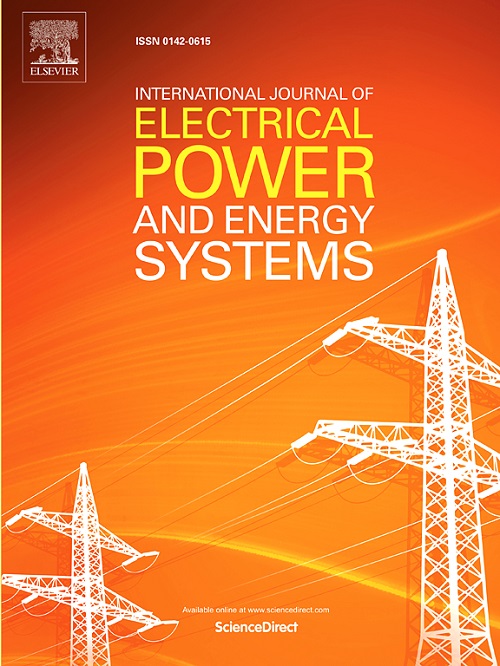城市私家车能耗系统的高分辨率仿真与预测:基于agent的建模
IF 5
2区 工程技术
Q1 ENGINEERING, ELECTRICAL & ELECTRONIC
International Journal of Electrical Power & Energy Systems
Pub Date : 2025-04-20
DOI:10.1016/j.ijepes.2025.110669
引用次数: 0
摘要
高精度的能源需求预测有助于应对未来汽车电气化的不确定性。采用基于智能体的模型对北京市分分钟能耗进行了模拟和预测。根据研究结果,提出了电网增强的建议,以解决与未来汽车电气化相关的不确定性。首先,构建基于智能体的仿真模型,对北京市同一系统内传统汽油车、混合动力汽车、插电式混合动力汽车和纯电动汽车的行为进行仿真。考虑到机动车能源消耗复杂的时空异质性,构建了以空间异质性为重点的情景1和以时间异质性为重点的情景2。在Scenario 1中,分析了北京市及其16个区各类车辆的总能耗和峰值瞬时能耗。然后,在情景2中,预测2024 - 2030年北京及其16个地区的总能耗和瞬时能耗。预计到2030年,北京的电动汽车数量将达到101.39万辆,比2024年增长1.3倍。这一增长预计将导致汽车总用电量增长1.5倍。在北京的16个区中,朝阳区的总用电量最高,增长速度最快。预计年用电量将从2024年的2.273亿千瓦时增加到2030年的321.08亿千瓦时。而怀柔的能耗最低,变化幅度最小。此外,我们观察到不同地区的峰值年增长率存在显著不平衡。因此,建议海淀区和朝阳区至少将现有容量增加一倍,以缓解整体电力需求。此外,从2024年开始,除怀柔、平谷区外,其余14个区应实施补网措施、智能电网调峰、动态充电等调峰管理政策,以应对预期的未来调峰。预计研究结果将为加强城市电网基础设施提供有价值的参考,以满足未来对电动汽车的需求激增。本文章由计算机程序翻译,如有差异,请以英文原文为准。
High-resolution simulation and prediction of urban private vehicles energy consumption system: Agent-based modelling
High-precision energy demand forecasting can help cope with the uncertainties of future vehicle electrification. An agent-based model is employed to simulate and forecast the minute-by-minute energy consumption in Beijing. Based on the results, recommendations for power grid enhancements are formulated to address the uncertainties associated with future vehicle electrification. Firstly, an agent-based simulation model is constructed to simulate the behavior of conventional gasoline vehicles, hybrid electric vehicles, plug-in hybrid electric vehicles, and pure electric vehicles in Beijing within the same system. Considering the complex spatiotemporal heterogeneity of motor vehicle energy consumption, two scenarios were established: Scenario 1, focusing on spatial heterogeneity, and Scenario 2, emphasizing temporal heterogeneity. In Scenario 1, the total energy consumption and peak instantaneous energy consumption of various vehicle types across Beijing and its 16 districts are analyzed. Then, in Scenario 2, the total and instantaneous energy consumption for Beijing and its 16 districts from 2024 to 2030 is projected. It is projected that by 2030, the number of EVs in Beijing will reach 1,013,900, representing a 1.3-fold increase from the 2024 figure. This growth is expected to lead to a 1.5-fold rise in total automobile electricity consumption. Among Beijing’s 16 districts, Chaoyang has the highest total electricity consumption and the fastest growth rate. Annual electricity consumption is projected to increase from 227.3 million kWh in 2024 to 32.108 billion kWh in 2030. In contrast, Huairou has the lowest energy consumption and the smallest variation range. Additionally, we observed significant imbalances in peak annual growth rates across different regions. Therefore, it is recommended that Haidian and Chaoyang districts should at least double their current capacity to alleviate overall power demand. Furthermore, starting from 2024, apart from Huairou and Pinggu districts, the remaining 14 districts should implement network reinforcement measures, smart grid peak regulation, dynamic charging, and other peak management policies to address the anticipated future peak growth. The findings are anticipated to serve as a valuable reference for the enhancement of urban power grid infrastructure in order to meet the future surge in demand for electric vehicles.
求助全文
通过发布文献求助,成功后即可免费获取论文全文。
去求助
来源期刊
CiteScore
12.10
自引率
17.30%
发文量
1022
审稿时长
51 days
期刊介绍:
The journal covers theoretical developments in electrical power and energy systems and their applications. The coverage embraces: generation and network planning; reliability; long and short term operation; expert systems; neural networks; object oriented systems; system control centres; database and information systems; stock and parameter estimation; system security and adequacy; network theory, modelling and computation; small and large system dynamics; dynamic model identification; on-line control including load and switching control; protection; distribution systems; energy economics; impact of non-conventional systems; and man-machine interfaces.
As well as original research papers, the journal publishes short contributions, book reviews and conference reports. All papers are peer-reviewed by at least two referees.

 求助内容:
求助内容: 应助结果提醒方式:
应助结果提醒方式:


